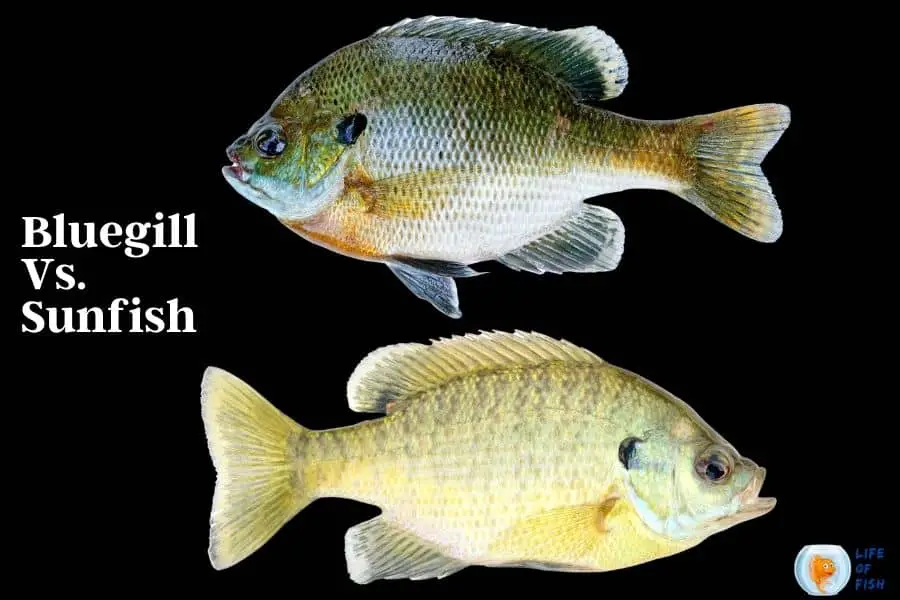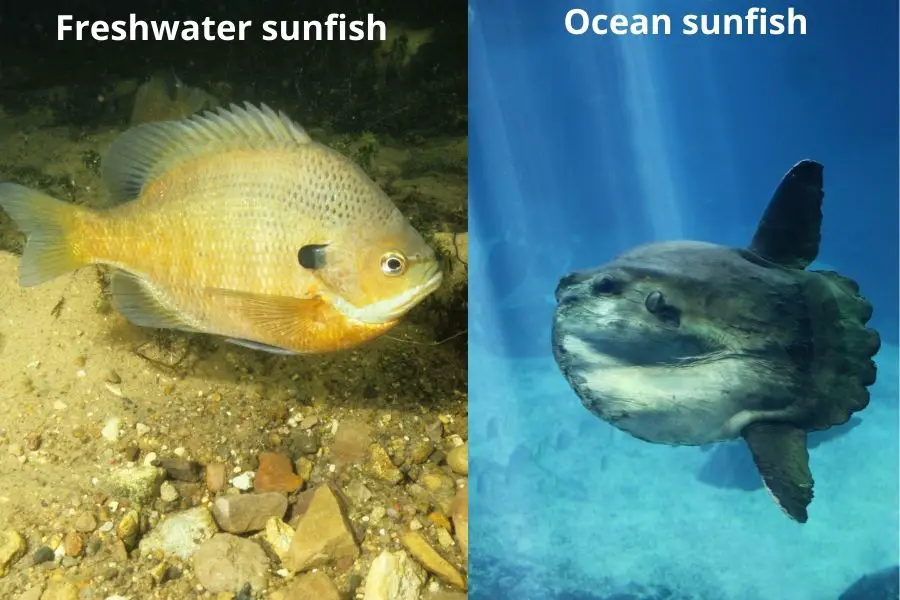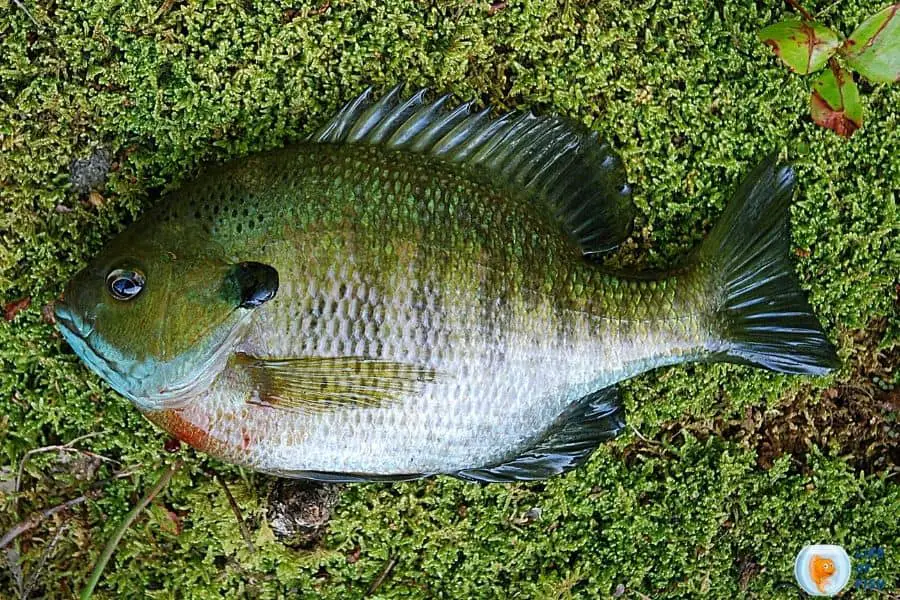Fishing can be confusing when you come across fishes that have the same look. Bluegill vs.Sunfish is one such situation.
Believe it or not, I have seen some articles that make this confusion more confusing by bringing a saltwater fish called Mola Mola between these species.
Therefore, I decided to lose the knots for your sake.

What is Sunfish?
Jump To
- 1 What is Sunfish?
- 2 What is Bluegill?
- 3 Why the Confusion?
- 4 What is the confusion with Sea sunfish?
- 5 The appearance of Bluegill vs.Sunfish
- 6 Distribution of Bluegill vs.Sunfish
- 7 Habitats of Bluegill vs.Sunfish
- 8 Diet of Bluegill vs.Sunfish
- 9 The behavior of Bluegill vs.Sunfish
- 10 Importance of Bluegill vs.Sunfish
- 11 Why the confusion?
- 12 How to identify each sunfish species?
Technically, Sunfish is a freshwater fish family called Centrarchidae. They are ray-finned fish that comprises 38 species, 2 of which are extinct.
Native to North America, there are eight genera of Centrarchidae. There are black basses, rock basses, perches, fliers, Crappies, mud sunfishes, banded sunfishes, and there are “true” sunfishes in this family.
True sunfish genera (Lepomis) has around ten fish species that look almost the same. But, other sunfishes except for banded Sunfish (Enneacanthus ) have distinct differences. Therefore, people often call Lepomis and Enneacanthus species “Sunfish.”
But, why did I mentioned Lepomis genera specifically? I’ll explain it to you in a moment.
What is Bluegill?
Bluegill is a species under the sunfish family, specifically under the Lepomis genera. (This is why I mentioned these genera earlier).
In the United States, they are also called bream, perch, copper nose, or Sunny based on their life forms. Anglers often refer to these species as simply “sunfish,” and that is, as you can see, is true.
Is Bream in Europe similar to bream in US?
Anglers in America call large colorful male Bluegill by the name “bream,” but in Europe, Bream is another fish species. Scientifically named Abramis brama, bream in Europe is actually a species of Minnow. So, if you travel to Europe and say you want to bream fishing’, you probably won’t find any bluegill there.

Why the Confusion?
Because all the sunfishes often have the same look, people confuse both fishes.
In fact, Bluegill is a sunfish, but not all Sunfish are bluegills.
What is the confusion with Sea sunfish?
Sea sunfish or ocean sunfish is an entirely different species than lake sunfish. Often called Mola Mola, these fish live in the ocean and weigh between 247 and 1,000 kg.
They are one of the two heaviest bony fishes in the world and live in tropical and temperate marine waters around the world.
Some mistake that some sunfish species live in saltwater, but they are not (although some sunfish can tolerate a certain amount of salinity, they are not considered saltwater fish).
Sunfish live only in freshwater. The Sunfish that lives in saltwater is actually Mola Mola. And mola mola is a marine fish species belonging to the Molidae family.
The fish we compare here are Lake sunfish (family) and Bluegill.

The appearance of Bluegill vs.Sunfish
Appearance-wise, both fish types have almost the same look. But, there are some specific colors and markings of Bluegills. Let’s dive in more.
Size
Bluegills grow up to 12 inches long and about 2kg in weight, while the largest Sunfish, largemouth bass, can grow up to 3.3 feet long. The smallest sunfish species of black-banded Sunfish grows up to 3.1 inches.
Color
The color of Bluegill can change from population to population.
But, they have a distinctive coloring of deep blue and purple on the face and gill cover, fiery orange to yellow belly, and dark olive-colored bands down the side.
Different species in the sunfish family have various color morphs. Each sunfish species has a unique color variation from silvery grey to reddish-brown, green, blue, and with and without spots and stripes.
Actually, this is how people distinguish between different sunfish species.
Shape
Bluegill has a compressed, saucer-shaped body like the other Lepomis and Enneacanthus species.
All other sunfish have a longer body than bluegills. It is hard to distinguish bluegills from other sunfishes from its body as many sunfishes have the same shape.
Male and female
The female Bluegill is typically larger than the male one. And also, the male colors are more bright and vivid than the female Bluegill.
Likewise, all sunfish species except for Micropterus develop an intense coloration between males and females. Males generally have bright, vivid-colored body and females have pale-colored bodies.
Distribution of Bluegill vs.Sunfish
Bluegill’s natural habitats are in shallow waters of lakes, ponds, streams, creeks, and rivers in Virginia, Florida, Texas, Mexico, Minnesota, and Newyork.
As of today, they are distributed in all of North America, Europe, South Africa, Asia, Zimbabwe, South America, and Oceania.
These are invasive species that have wreaked havoc with native species in introduced countries. Therefore, many countries declared this species a pest.
Likewise, all other sunfish habitats are in ponds, lakes, medium to low flow streams and rivers, and swamps in North America.
Like Bluegill, some sunfish species like largemouth bass are introduced in other countries, and since then, these species have become invasive.
The reason is that all sunfish species are very hardy species that can tolerate different temperatures and salinity levels to some extent. So, they adapt to any water condition effortlessly.

Habitats of Bluegill vs.Sunfish
As Bluegill is a sunfish species, all sunfish species have the same habitats in ponds, lakes, medium to low flow streams and rivers, and swamps in North America.
However, each species has specific water columns that will be useful in identifying the particular species.
For example, bluegills usually live in deeper littoral zones whereas green Sunfish inhabit near the shoreline and shallower areas.
Sacramento perch can survive unusually high alkalinity, salinity, and temperatures in their habitats.
Diet of Bluegill vs.Sunfish
All sunfish species are carnivores. Depending on the size of the fish, they feed on rotifers, copepods, worms, insects, invertebrates, crabs, crayfish, and other small fish.
Some sunfish species are suction feeders, while others are ram feeders.
Bluegill, on the other hand, is an omnivore species. They are suction feeders that generally feed off the bottom of their habitat and eat anything that fits in their mouths.
Bluegills mostly feed on small insects and fish. But, these fish become prey on other large predators, including northern pike, walleye, muskies, snapping turtles, and other large sunfish species like largemouth bass and yellow perch.
The behavior of Bluegill vs.Sunfish
All sunfish species, including bluegills, are prolific breeders. A male sunfish will sweep or fan out a dish-shaped nest.
Once a sunfish nest has been constructed, male Sunfish will vigorously guard their nests against any intruders who approach near the nest.
Female Sunfish lay the eggs in these nests while the male fertilizes them. The male Sunfish protects these fertilized eggs until they hatch.
All sunfish species are schooling fish. They will usually school in groups of 10 to 20 fish and feed on primarily in low light conditions at dawn or dusk.
But these fish are opportunistic feeders that will feed whenever the meal presents itself.
Importance of Bluegill vs.Sunfish
Bluegills and all other Sunfish are as important in fisheries as game fish. Anglers love these species in sportfishing because of their high speed and the ability of backward swimming.
The ability to multiply and thrive sunfishes is a blessing in some areas, while it has been a nuisance in most areas.
Bluegills and most other Sunfish are invasive species that can cause the extinction of native fish species in countries other than North America.
Therefore, some countries like Germany and Japan have banned trading some sunfishes to protect their native fish species.
Sunfishes, especially bluegills, play an important role in keeping crustaceans and insect populations low in ponds and lakes.
A single bluegill population can consume up to six times its own weight in a single season.

Why the confusion?
Many people confuse Sunfish as bluegills, while in truth, the Bluegill is a sunfish.
This is because most sunfish species have the same shape and live in the same habitats as bluegills. But, if you observe carefully, you can distinguish bluegills from Sunfish easily.
Apart from the distinct colorations, bluegills have three main unique features. Bluegills have long dorsal fins than other sunfish species.
They also have a Dark Opercular ear flap and a Dark spot or blotch at the end of the dorsal fin.
The appearance of bluegills may change due to various reasons such as size, regional location, diet, sex, and water quality.
However, they mainly have deep blue and purple colors on the face and gill cover, fiery orange to yellow belly, and dark olive-colored bands down the side.
How to identify each sunfish species?
Of all the 38 sunfish species, more than 11 sunfish look almost the same. The Lepomis genera are too hard to distinguish.
But, luckily, there are many resources online that can help you identify the fish you catch. Here are some tips for identifying the sunfish species you catch.
- Document the place, the equipment you used to catch the fish, and the time you caught it in a notebook
- Measure your catch, including the length of the fish and the weight.
- Photograph your catch on both sides with a ruler or a measure as a reference
With these data, you can seek help online or from the state fish and wildlife agency.
All 50 states in the US have a department of natural fisheries staffed with biologists that can help you identify your catch.
Read Next : Haddock Vs. Cod : Who Is The Best? | 11 Facts To Consider |
